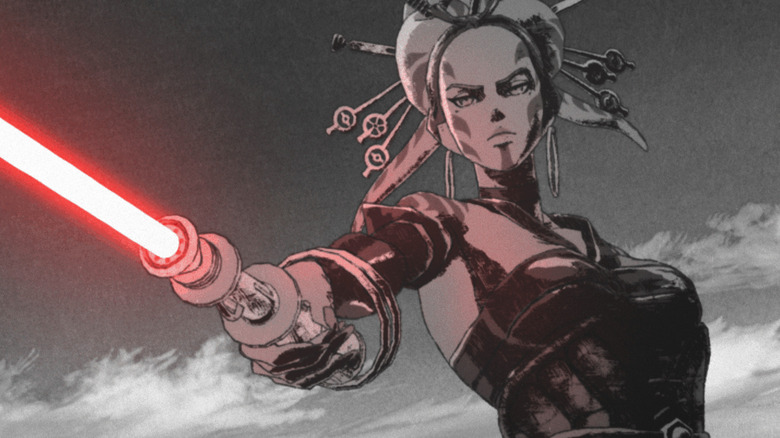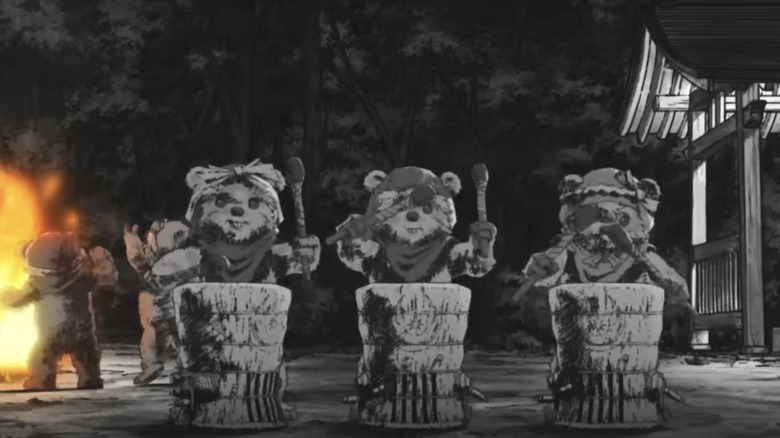Star Wars: Visions Season 3 Inverts Return Of The Jedi In A Brilliant Way
"The Duel" is one of the standout episodes of "Star Wars: Visions." Its mix of Akira Kurosawa-style black-and-white film grain and pops of colored energy give it a unique look, while its computer-generated-meets-hand-drawn animation style has a kinetic energy that makes it irresistible. It also tells a metaphysical story that's as deep and complex as the "Star Wars" saga itself. In the span of 13 minutes, it introduces a Sith who's hunting other former Sith and appears to be fighting on the side of good. The Jedi, meanwhile, are aligned with the malevolent Crusaders, turning the "Star Wars" universe upside-down.
Emma Mieko Candon later doubled down on these ideas with the novel "Star Wars Visions: Ronin," both inverting and reinforcing the philosophies of the "Star Wars" mythos in the most fascinating ways. Now, "The Duel" director Takanobu Mizuno is back with a follow-up for "Visions" season 3 titled "The Duel: Payback."
Like "The Duel" before it, "The Duel: Payback" takes its cues from Kurosawa's "Yojimbo." Just as Toshiro Mifune's rōnin is battered within an inch of his life and requires rescue and recuperation in Kurosawa's film, so too does the Ronin from "The Duel." However, instead of trying to capture and eat him, Ewoks rescue and heal the Ronin in the hot springs of their mountainous home, nursing him back to health so he can once again fight the Crusaders. This is the first major inversion of "Star Wars: Episode VI — "Return of the Jedi" in "The Duel: Payback."
Donning swimming goggles, the Ewoks lay their primitive traps beneath a bridge and awaits the Crusaders in the water. When the trap is unleashed, they go into a full on murderous rage against the Jedi and their allies, a complete 180 from their role in "Return of the Jedi."
Visions season 3 inverts elements of multiple Star Wars films
The second major inversion of "Return of the Jedi" comes with the Grand Master, the central antagonist of "The Duel: Payback." He's a Jedi hunting the Sith, but he's also subjugating the story's setting at large, killing civilians willy-nilly. It doesn't matter who gets in his way; he's willing to put the entire planet on lockdown, blockading everyone and making their lives miserable, in order to find the recuperating Ronin. This recalls Darth Vader and the many horrible things he did over the years in service to Emperor Palpatine.
The Ronin sets his trap with the Ewoks, paving the way for his final duel with the Grand Master (who he appears to have some history with). The Grand Master looks human, but as the battle rages, it turns out he has several mechanical elements. As pieces of him are hacked off and damaged, his faceplate comes off, much like Vader in "Return of the Jedi." But where Vader removing his faceplate was a reflection of his turn back to the light, the removal of the Grand Master's faceplate represents his decision to discard his humanity, losing himself in the dark.
This is a brilliant bit of symbolism that both plays on and alters our understanding of the common symbols and tropes we know and love from the "Star Wars" films. "The Duel: Payback" similarly inverts the "Duel of the Fates" sequence from "Star Wars: Episode I — The Phantom Menace" by making a Jedi Grand Master the villain in a showdown between the Sith and Jedi. There is a rich tapestry of storytelling here, and it's layered with more depth than one might think upon first glance.
The first three seasons of "Star Wars: Visions" are streaming on Disney+.

